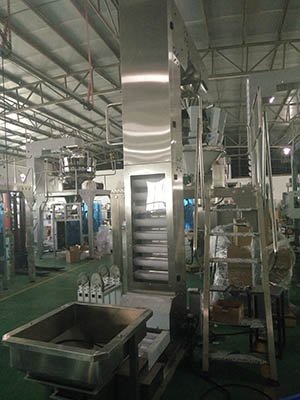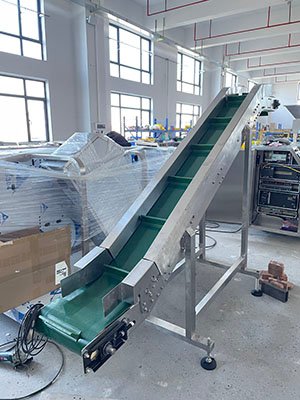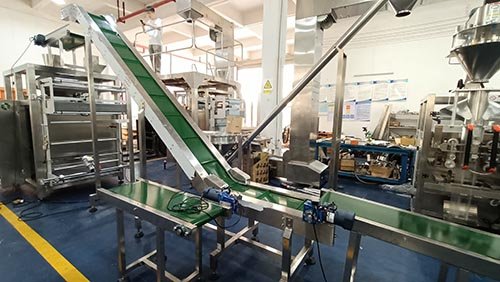Introduction
In the packaging production process, product feeders/conveyors are key equipment that connect various production and packaging links. Efficient cooperation with packaging machines can significantly improve production efficiency and quality.
When you choose the wrong conveyor, the product cannot be delivered in time or materials are left on the conveyor, causing waste. What kind of conveyor should be selected for the product to better cooperate with production work? Read on, this article will introduce you to Z-type feeding, screw feeding, belt feeding and other conveyor types that can be used with packaging machines, and explain their working principles, Application and advantages in detail.
L-type chain bucket belt conveyor

L-type chain bucket belt conveyor is a conveying equipment that integrates the advantages of belt drive and chain bucket structure. It is mainly composed of belts, chain buckets, drive devices, frames and other parts. As a conveying carrier, the high-strength belt has the characteristics of wear resistance and tensile resistance, which can ensure long-term stable operation; the chain bucket is evenly installed on the belt, and its shape and size can be customized according to the material characteristics, and the number of chain buckets can also be customized according to your production capacity. The more the number, the faster the conveying speed and the higher the production capacity.
The L-type chain bucket belt conveyor is driven by a motor, which can accurately control the belt running speed to meet the diversified production needs. It can automatically load the product with the vibrating silo. However, it should be noted that when customizing the L-type chain bucket belt conveyor, the chain bucket type and belt material should be reasonably selected according to the characteristics of the material to avoid the mismatch between the material and the equipment, which will lead to a decrease in conveying efficiency or damage to the equipment.
Working principle: 1. After the equipment is started, the drive device drives the belt to circulate, and the chain bucket moves accordingly.
2. When the chain bucket passes through the silo, the vibrating silo automatically puts the material in,
3. With the transmission of the belt, the material is smoothly lifted to the specified height, and then discharged through the discharge port to complete the feeding process.
This achieves continuous and efficient transportation of materials, reduces manual intervention, and improves production efficiency.
Application: L-type chain bucket belt conveyor is widely used in many industries. In the grain processing industry, it can be used to lift and transport raw grains such as wheat and rice, and efficiently transport grains in the warehouse to the processing equipment; it is also commonly used for the transportation of food or non-food materials such as powder, granules, and small pieces of materials. We usually use it for non-sticky products.
Advantages:
- The belt can transport materials continuously and smoothly, suitable for light and medium-sized materials.
- High conveying efficiency, can complete the lifting and transportation of a large amount of materials in a short time.
- Strong adaptability, whether it is powder, granular or small pieces of material, it can be transported stably.
- Long service life, as long as the equipment is regularly inspected and maintained, including checking the wear of the belt, the tightness of the chain bucket, the lubrication status of the drive device, etc., and the vulnerable device is replaced in time after wear, so that the equipment maintains a good operating state, it can usually be used for 8-15 years.
Z-type bucket chain conveyor

The Z-type bucket chain conveyor has a unique Z-shaped structure, which is mainly composed of core components such as bucket, traction member (usually chain), drive device, tensioning device, casing, etc. The number of buckets can be customized according to the production capacity you need.
The working principle is similar to that of the L-type belt chain bucket loader, except that the bucket is rotated by the chain. At the low-level feed port, the bucket is filled with materials by vibration. The chain bucket runs along the Z-shaped track with the chain. The bucket passes through the vertical rising section and the horizontal conveying section in turn, and finally at the high-level discharge port, the material is discharged by centrifugal force or gravity, completing the material from low to high.

Application: The Z-type bucket chain conveyor has strong compatibility with material types. Whether it is granular grain, feed (such as handmade beef balls, wheat, rice, grains, flour, etc.), powdered cement, chemical raw materials, or small pieces of ore, coal, etc., it can be stably transported. By choosing hoppers of different materials, shapes and sizes, we can effectively deal with the differences in material viscosity, abrasiveness, fluidity, etc., ensure that the material does not fall or clog during transportation, and ensure production continuity.
Advantages:
- The Z-shaped structure makes full use of the vertical space and corner areas of the factory, and is especially suitable for production workshops with compact space.
- During the operation of the equipment, the material is always carried and transported by the hopper in the closed casing, effectively avoiding dust flying and material leakage, and reducing material loss.
- Long service life, as long as the key components such as chains and bearings are lubricated and maintained according to the cycle; replace the hoppers, belts and other vulnerable parts that are severely worn in time to ensure that the equipment is always in good operating condition.
conveyor belt (without chain bucket)

The conveyor belt is mainly composed of belts, rollers, frames and drive motors. Among them, the belt, as the core conveying component, is usually made of rubber, PVC (polyvinyl chloride), PU (polyurethane) and other materials. According to different usage requirements, the belt surface can also be designed as a smooth surface, patterned surface, climbing belt and other special forms.
Working principle: The material to be transported is placed directly on the belt, and the friction between the belt and the material and the support of the roller are used to realize the continuous transportation of the material. During the transportation process, the roller supports the belt and the material, ensures the smooth operation of the belt, and reduces the sagging and deviation of the belt.
Application : Whether it is granular grain, sand and gravel, block ore, coal, or boxed and bagged finished goods, they can be stably transported on the belt. On the production line, the belt feeder can transport fruits and vegetables to the processing station, or transport packaged food to the boxing and stacking links; in addition to the use of production lines, belt conveyors are also widely used for the transportation and sorting of e-commerce packages, and even in the building materials production industry, they can be used to transport raw materials, semi-finished products and finished products to meet the material transportation needs of large-scale production.
Advantages:
- The conveying length, width and inclination angle can be flexibly adjusted according to actual production needs.
- During operation, the material maintains relatively stable contact with the belt, and the conveying process is continuous and smooth, avoiding losses and environmental pollution caused by material bumps and spills.
- Through the combination of multiple belt conveyors, complex conveying path planning can be achieved, such as turning conveying, branch conveying, etc., which can easily cope with diverse production layouts.
- The belt feeder can be integrated with other automation equipment to build a complete automated production line.
- Easy maintenance and long life. By regularly checking the wear of the belt, adjusting the belt tension, and lubricating key components, the long-term stable operation of the equipment can be ensured, reducing the company’s equipment maintenance costs and downtime.

The above is all the content of this article. In the next article, we will introduce more material conveyors/feeders. Follow our Facebook to get more latest information. If you want to know the conveyor price, please contact us via WhatsApp!
